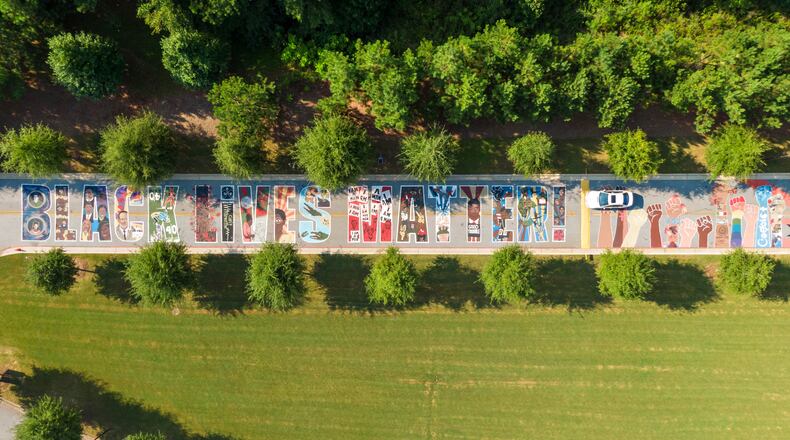For the first few years of its existence, Utopian Academy of the Arts had no physical identity. There was no marquee with the school name. No name engraved above the entrance. No way to know exactly what was happening inside the building.
Earlier this month, after so many years, the K-12 charter school network in Ellenwood unveiled a 20-foot public mural visible from Forest Parkway designed to make a very clear and flamboyant statement, said founder and executive director Artesius Miller.
“Our initial goal to develop a mural was for us to communicate what our school community values and appreciates,” Miller said. “It is an outward expression of our identity and gives us the means to showcase who we are to the larger community that might not have the pleasure of walking through the walls of our facility.”
Designed by local artist Chastain Bernard Clark, the mural features the school name on a backdrop of musical notes rendered in remixed primary colors. The notes are the original sheet music for “Respect” as written by Georgia musician Otis Redding and later popularized as a feminist anthem by Aretha Franklin. “When kids pull up on the bus or pass it on Forest Parkway … they point to it and feel a sense of pride,” said Clark. “It is Utopian’s vision of kids … knowing they are worthy of respect, demanding it and being proud of it.”
Credit: Courtesy of Chastain Bernard Clark
Credit: Courtesy of Chastain Bernard Clark
The mural is one of two school murals Clark has completed recently and is evidence of a growing desire for public art in educational spaces. But one of the biggest hurdles for these projects is funding, said Clark. Many schools do not have the funds to cover the cost of murals, so they may turn to grants or private funding, sources which are not always readily available. “We have to find ways to fund more murals at schools,” Clark said.
Street art or urban art had its earliest beginnings in the 1960s as graffiti, but the art form has since evolved into one of the most meaningful artistic movements of the late 20th century, bringing political and social messages to public spaces.
In the past decade, city planners across the country have embraced public art to encourage community dialogue and create a sense of place, but the art form wasn’t always appreciated for its ability to inform and educate.
Organizations like Living Walls have worked to increase public awareness of murals in metro Atlanta, partnering with artists to bring murals to schools such as Cross Keys High School in DeKalb County. Artists are also working independently with schools to design and execute murals, as did Kyle Brooks in 2018 when he turned a stairwell at Mary Lin Elementary School in Atlanta into a dreamy scene of smiling trees, rockets and cats with funny legs.
When the coronavirus pandemic and social justice protests of the past year pushed public art to new levels of urgency, interest intensified at schools as administrators and students sought to make important statements about their communities.
“There has been a culture around street art for more than 30 years, but it was rare to see that at schools,” said Clark. If schools had murals, they were most likely found on the interior walls, he said. “At schools ... awareness is still catching up to the way the art world sees it.”
In 2019, Clark also completed a mural at Avondale Elementary School. The mural, a vibrantly colored, whimsical design on the side of the building that faces Covington Highway, is meant to indicate that something interesting is happening inside the school, he said
“It is a unique experience when you are viewing street art, whether you know it or not,” said Clark.
Before the pandemic, at Drew Charter School’s Junior Academy, students in a relatively new class that folds social justice into a STEAM curriculum were inspired by a traveling exhibit on Black art and activism from Emory University.
Some students participated in the protests and demonstrations that took place in the summer of 2020, and they returned to the class ready to continue taking action. They began studying social justice art around the world and decided they wanted to create a mural on the campus.
Credit: HYOSUB SHIN / AJC
Credit: HYOSUB SHIN / AJC
“Initially, I thought it would be a mural that said Black Lives Matter because that is what we saw in other cities, but the students wanted to do more than that,” said Sterling Slaughter Sr., who teaches seventh grade and high school. “They said we need to include a side that shows solidarity and the rest of the community.”
The result is a 200-by-18-foot mural on the driveway of the campus designed, executed and installed by students and community members with the help of local artists. Lisa Whittington, a Georgia-based artist known for her social justice artwork, is a teacher at Drew and helped students conceptualize and expand their ideas.
They walked the property looking for the right space to locate the mural and then developed a plan in which each letter of “Black Lives Matter” depicts an aspect of Black life in America, from honoring the school’s namesake Dr. Charles Drew to an intricately designed fruit tree bearing the names of lynching victims from Georgia.
The other side of the mural is a series of raised fists each representing a marginalized community — LGBTQ, Indigenous Americans, people with autism, women, Asian Americans and Pacific Islanders and Latino communities, etc. — all in solidarity with one another.
Credit: HYOSUB SHIN / AJC
Credit: HYOSUB SHIN / AJC
It is a beautiful, permanent reminder of the real work that needs to be done, said Slaughter. “The struggle for equality and equity is not over and it doesn’t end in a move like this,” he said.
The mural itself tells a story, but so does the work that went into it. For three weeks, during a global pandemic, students, teachers, residents and people who had no connection to the school but just wanted to help all worked together to complete the mural. One student who worked on the project makes regular visits to elementary school classrooms to talk to younger students about how the mural was created.
Clark, who is also earning a master’s degree in digital fabrication at Georgia Tech, included a QR code on the mural at Utopian that links to photos and video. The idea is that years from now, observers will be able to see the installation process and learn how the mural evolved, he said.
The murals at these schools helped bring a sense of pride, strengthen the school and surrounding communities and spark dialogue around important issues. Those are qualities that any school should want to encourage.
Read more on the Real Life blog (www.ajc.com/opinion/real-life-blog/) and find Nedra on Facebook (www.facebook.com/AJCRealLifeColumn) and Twitter (@nrhoneajc) or email her at nedra.rhone@ajc.com.
About the Author
Keep Reading
The Latest
Featured






